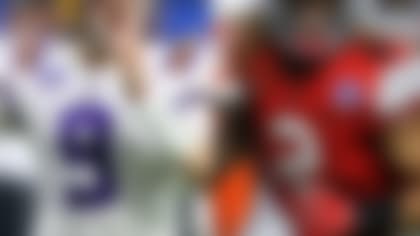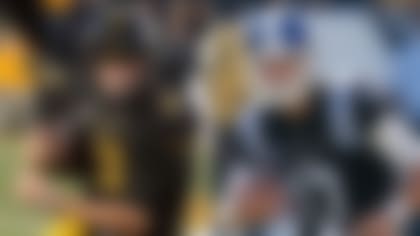Projecting the success of college football stars to the NFL is an inexact science.
Teams have to be willing to take a chance on the upside of a player in the hopes that they can help him become a difference-maker. NFL coaches will always believe they can mold a player with great athleticism into a great player -- because that's their job.
This is why players are sometimes taken in the first round based more on potential than production. This is also why some players don't have the careers that their draft position portends.
The 10 players below all have a chance to be excellent NFL players. However, scouts also have concerns about their games that they will be able to point to down the road and say "I told you so" if these players' pro careers do not meet expectations.
I highlighted the draft's safest prospects last week and now, here are the top 10 boom-or-bust prospects, ranked according to their volatility (No. 1 with the most).
You'll note a lot of the players are quarterbacks and defensive linemen; this is not an accident, as players picked at those two positions have produced a large share of disappointing careers among those picked near the top of recent drafts.
10) Harold Landry, EDGE, Boston College
Best teams fits:Green Bay Packers, Tennessee Titans.
Analysis: If Landry would have entered the draft after his outstanding 2016 campaign, he would not have been on this list. He was an All-American as a junior, racking up 22 tackles for loss, including 16.5 sacks. His senior year was not nearly as productive (8.5 tackles for loss, five sacks) due to an ankle injury. Landry's NFL Scouting Combine (March 2-5 on NFL Network) performance will be key, as teams want to find out if he's an elite athlete. His natural bend as a rusher is tremendous, however, so his potential to wreak havoc off the edge is there -- teams just aren't sure if they'll get the dominant 2016 pass rusher or the 2017 version of Landry.
9) Orlando Brown, OT, Oklahoma
Best team fits:Baltimore Ravens, Buffalo Bills.
Analysis: The son of Orlando "Zeus" Brown is similar to his late father in that he is a one-man solar eclipse. Listed at 6-foot-8, 345 pounds, he has the length and pure bulk to push pass rushers around the pocket so that his quarterback can get the ball away or a running back can find a hole. But Brown's size can be a disadvantage against quicker pass rushers, as he takes time to slide that frame laterally. Once Brown stops his feet, better rushers can accelerate past him with a secondary rush that could be an issue if the ball isn't yet out of the pocket. The big man has nimble enough feet, though, that Sooners coaches used him on traps inside and on second-level blocks. I suspect he'll be a fine starting tackle in the league for many years, but he'll need to keep his feet active and keep from straightening up out of his stance to reach his potential.
8) Andrew Brown, DL, Virginia
Best team fits:Green Bay Packers, New England Patriots, Washington Redskins.
Analysis: Brown's physical prowess is no joke. When he's using his 6-3 1/2, 285-pound frame and 35-inch arms to their fullest, he can be disruptive. His athleticism might push a team to use a top-50 pick on his talents, banking that he will flourish in their system. Despite being a five-star prospect out of high school, however, Brown struggled to make an impact in his first two seasons with the Cavaliers, totaling just 10 tackles (three for loss) combined in 2014 and 2015. He stepped up in his final two years in Charlottesville (13 TFL, six sacks in 2016; 10.5 and 3.5 in 2017), moving from defensive tackle to defensive end. The lack of production early in his collegiate career and decrease in big plays as a senior will be a red flag to some teams. General managers saw him flash a nice power-agility combination at the Senior Bowl, though, and he will likely impress at the Combine. That leads to the ultimate conundrum for NFL decision-makers looking at any high-ceiling, low-floor prospect: Has Brown matured sufficiently so that he can be an above-average starter at the next level?
7) Malik Jefferson, LB, Texas
Best team fits:Philadelphia Eagles, Pittsburgh Steelers.
Analysis: Jefferson's size, strength, and athleticism earned him five-star ratings as a recruit, the High School Butkus Award in 2014, All-American notice with the Longhorns, and the Big 12 Co-Defensive Player of the Year award. NFL scouts aren't so sure he's going to be a difference-maker at the next level, though. They question his instincts and playmaking ability. Jefferson has the physical tools to be an outstanding inside 'backer in a 3-4 scheme or Sam in a 4-3, making a squad's run defense stronger and providing some pass rush when called upon. If he plays to his potential, he could end up being a great find in the top 50 picks.
6) Hercules Mata'afa, DL, Washington State
Best team fits:Baltimore Ravens, Carolina Panthers, Pittsburgh Steelers.
Analysis: Here's the thing about Mata'afa: NFL teams aren't sure what his best position will be. He's lined up mostly inside for the Cougars despite being listed at 6-2, 252, and that's not going to work in the NFL. So will he add weight to play the three-technique spot? Or can he stand up? Does he have the bend and agility to play the edge against larger offensive tackles on Sundays? Or is he best as an inside linebacker who will attack A-gaps to play the run or pass. It's just not clear. What is clear is that he's been a load for college linemen to handle because of his get-off and relentless nature. Excelling in agility drills during the combine and the school's pro day will help teams find a role for him in their scheme. If that happens, and he can execute the plan -- to quote the late Ronnie James Dio: Look out!
5) Baker Mayfield, QB, Oklahoma
Best team fits:Arizona Cardinals, New York Giants, New York Jets.
Analysis: I believe Mayfield will be a longtime NFL starter who uses his ultra-competitive nature to lead a team to the playoffs on a regular basis. However, he'll have to answer some questions to at least one team's liking before they hand him the reins of their franchise. To me, the comparison of Mayfield to former Cleveland Browns first-round pick Johnny Manziel on a personal or football level doesn't make sense. Mayfield is a more standard pocket passer than Manziel ever was, and while Mayfield was arrested last year for public intoxication, I don't see any reason to equate that to Manziel's off-field issues. However, Mayfield's arrest and his on-field antics mean that NFL teams will investigate whether he has the maturity to be a reliable leader. Mayfield measures just over 6-feet tall, as well, which will be viewed as a problem by some teams even though less-than-ideal height hasn't kept QBs like Drew Brees and Russell Wilson from becoming superstars. Even if all of that is not a an issue for teams, there's still the "Air Raid Offense" label placed on Big 12 quarterbacks coming into the league. Fair or not, teams will have questions about Mayfield's ability to consistently move an offense from a dirty pocket without consistently relying on the ability to go over the top to wide-open receivers.
4) Marcus Davenport, EDGE, UTSA
Best team fits:Chicago Bears, Miami Dolphins.
Analysis: Davenport is a classic late-bloomer prospect, going under the recruiting radar because of his string-bean build in high school. He built up his strength during his time at UTSA, though, and finished with a great last two seasons with the Roadrunners. Davenport's work during the Senior Bowl showed that he has the raw talent to be a powerful edge rusher, but some development of his game would help him take the next step. The question is: How high will a team select him? I believe it will be early, making it a high-risk, high-reward selection.
3) Lamar Jackson, QB, Louisville
Best team fits:Arizona Cardinals, Buffalo Bills.
Analysis: In my mind, Jackson is worthy of a first-round selection. He has a strong arm, is a tenacious leader, and obviously has elite running ability to make defenses pay for playing straight-up man coverage. He has potential similar to Michael Vick's coming out of Virginia Tech in 2001. Teams just aren't sure about Jackson's pocket presence or accuracy under pressure. His lack of experience under center won't help, either, but the league is running more shotgun play-action and run-pass option plays, which fits his skill set. Jackson's lean build also makes team wonder if he will suffer injuries similar to Robert Griffin III when taking off from the pocket -- though I don't think anyone who has watched the Jackson over the past couple of seasons would question his toughness. If you watch Jackson's film, you'll find he's capable of finding the second or third option from the pocket, and he does come out from under center at times. So is he a boom-or-bust prospect? Yes, but I think most of the questions in his game can be asked of most other quarterbacks coming into the league. His upside as a playmaker is tough to duplicate.
2) Arden Key, EDGE, LSU
Best team fits: Kansas City Chiefs, New York Jets.
Analysis: Key showed great promise in his first two years with LSU, racking up 16 sacks in 23 games using his length, power, and speed. He took a leave from the team last spring for personal reasons, however, and then underwent shoulder surgery, which prevented him from full participation in summer camp. When he did return, he wasn't in good shape. Key did have five sacks in eight games in 2017, showing glimpses of his talent as he got healthy. Scouts still have questions about the leave he took from the team and the consistency of his effort to fight through better blockers on the edge. There is great potential in his speed and length as a pass rusher, but great concerns about his bust potential, as well.
1) Josh Allen, QB, Wyoming
Best team fits:Buffalo Bills, New York Giants.
Analysis: It will not be surprising if the Cleveland Browns select Allen with the first overall pick, but his best fit might actually be to play behind Tyrod Taylor or Eli Manning for a year. His play during Senior Bowl week showed scouts a glimpse of what his raw physical tools could produce when surrounded by NFL talent. On the other hand, he has a career completion rate of 56.2 percent, well below the 60-pecent threshold teams want to see. His junior year was a wash due to injury and poor performances against better teams early in the year (combined 32-for-64, 234 yards, three interceptions, and no scores against Iowa and Oregon). There's much to like about Allen's game, and Allen himself -- enough, in fact, to project him as a top-six pick despite his mediocre college career.
Follow Chad Reuter on Twitter _@chadreuter_.









